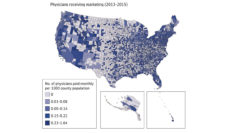Researchers from Boston Medical Center were selected to represent Massachusetts as one of four state research sites to participate in a $350 million study to address the opioid epidemic. Funded by the National Institute of Health (NIH), the HEALing Communities Study includes three other states hit hard by the opioid epidemic: New York, Kentucky, and Ohio.
The study aims to reduce opioid-related deaths by 40% over three years in all four states, “a bold goal,” according to Jeffrey Samet, the principal investigator and chief of general medicine at Boston Medical Center. Originally, the funding was going toward four independent studies. But shortly after the grant awards were issued, principal investigators from the four states met and joined forces using a common study design. The hope of the researchers is have people who misuse opioids move to long-term medication treatment. Three medications—buprenorphine, methadone and naltrexone—have been shown to increase the survival of persons with opioid use disorder.
Opioid-related deaths in Massachusetts have increased fivefold since 2000, in part because of the proliferation of fentanyl in the Northeast. However, a lot of progress has been made in the state to address the epidemic already and the number of overdoses has leveled off in the past 18 months.
“For some, it’s family members, and for others, members of their community have been impacted–and we see this across racial and socioeconomic lines.”
The four-state Healing Communities Study will involve 67 communities. Communities were selected based on their prevalence of overdose mortality and include urban and rural populations. Coalitions in each community will have the opportunity to select interventions that will increase medication use according to their community’s unique needs. “We’ll have a menu of options for communities to choose from,” Samet explained, “to see if addressing their perceived needs will have the impact we’re hoping for.” A partnership with the Massachusetts Department of Public Health to roll out the intervention and track important data is a key aspect of the study.
The study represents an enormous national effort to learn what works and what doesn’t in reducing opioid-related deaths, and lessons from this study will help inform other efforts happening around the country to prevent overdoses and rehabilitate individuals. “It’s pretty striking how many people know someone who has been affected by an opioid overdose,” said Samet. “For some, it’s family members, and for others, members of their community have been impacted–and we see this across racial and socioeconomic lines.”
Reducing the stigma of participating in addiction treatment will be a huge part of the effort, Samet explained. “We want to get people who have never seen medication to come in. And we need to decrease the stigma associated with having an opioid use disorder and with receiving medication chronically to treat that all-to-common medical condition. That’s the work that lies ahead.”
Photo by Tyler Springhetti on Unsplash














